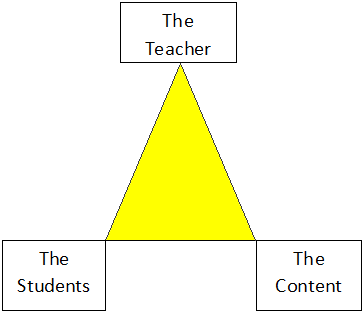Interaction between Students & Teachers in the Classroom
Tomlinson framed the daily interaction between students and teachers in the classroom as an equilateral triangle, with the three tips representing the content, the student, and the teacher.
(Adapted from Tomlinson, 1999, p. 27)

Although there is technically no “top” to the triangle, which represents “artful teaching” (p. 27), Tomlinson placed a priority on the role of the teacher in leading the classroom. As she put it (Tomlinson, 1999), “The teacher is the inevitable leader in any effective classroom. Leadership can and should be shared with the learners, but responsibility for the leadership resides with the adult who is charged by professionalism, tradition, and law with that task” (p. 28). Tomlinson also asserted that in order for a teacher to lead instruction effectively, he must be “secure about himself” (p. 28). However, that self-assurance doesn’t mean that such a teacher has all the answers (p. 28):
Instead a secure teacher expects to be a learner all day, every day, and he is comfortable with the ambiguity of that role. It’s not so important to be right as to be open. It’s not so important to have all the right answers as to be hungry for them. A secure teacher comes away from today with important questions to puzzle about overnight and the belief that today contains the insights necessary for a more effective tomorrow. A secure teacher believes that having these kinds of insights is professionally challenging and personally satisfying. Further, the secure teacher accepts the reality that he controls the climate in the classroom. His approach to students and instruction determines whether respect, humiliations, delight, drudgery, possibility, or defeat wins the day. He knows that he will err some days, but he also knows that he has the capacity and responsibility to avoid the same error another day.